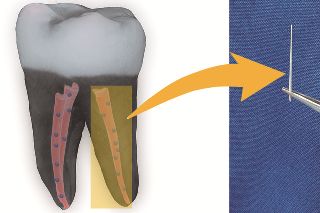Oct 20 2015
A team of researchers at the UCLA School of Dentistry has discovered that nanodiamonds can effectively strengthen a material used for filling teeth during root canal procedures, and can prevent residual infection post treatment.
 A 3-D image of a tooth filled with nanodiamond-enhanced gutta percha, and an individual gutta percha point.
A 3-D image of a tooth filled with nanodiamond-enhanced gutta percha, and an individual gutta percha point.
This latest breakthrough may benefit patients undergoing such root canal procedures. The study has appeared in the current issue of ACS Nano, a peer-reviewed journal.
Nanodiamonds are small particles that are many times smaller than the thickness of a human hair. They form as byproducts during mining and refining of diamonds, and have been extensively studied for use in a wide range of applications, including dentistry, imaging, cancer therapy, and regenerative medicine.
Root canal treatment is a frequently performed procedure. In fact, over 15 million of these procedures are being carried out in the US alone every year. The aim of the dentists is to save the teeth from the inflamed and infected dental pulp, which constitutes a part of the tooth containing nerve tissue and blood vessels. During this procedure, dentists remove the inflamed dental pulp and fill the vacant space with gutta percha, a type of polymer material. However, this material is only utilized in part so that it does not cause any reaction in the body.
Despite this, some procedures fail to remove the infection completely, and the remaining infection can result in loss of tooth. Moreover, the current gutta percha material is not suitable because it lacks the desired optimal rigidity and cannot completely prevent infection. In order to resolve these problems, two kinds of reinforced gutta percha were developed and tested by the UCLA researchers. One material was fortified with nanodiamonds, and the other was enhanced with nanodiamonds to which antibiotics were already added.
Study co-authors, Adelheid Nerisa Limansubroto and Sue Vin Kim who are UCLA Dentistry students, assessed the first type of reinforced gutta percha by filling the actual human teeth. With the help of standard micro-computed tomography (CT imaging) and radiography methods, they demonstrated that the gutta percha enhanced by nanodiamonds can be employed for filling the tooth. It was observed that tiny gaps remained in the canal when nanodiamond-reinforced material was used, similar to the conventional formulation. This can possibly lead to bacterial growth. However, the CT imaging technique revealed that the space was effectively filled up by the reinforced compound just like the standard gutta percha material.
“Validating this novel material in teeth extracted from patients serves as a strong foundation for the potential translation of nanodiamond-reinforced gutta percha toward clinical testing,” said Dean Ho, a senior author of the study, co-director of UCLA Dentistry’s Jane and Jerry Weintraub Center for Reconstructive Biotechnology, and professor of oral biology and medicine. Ho also serves as a professor of bioengineering and a member of the UCLA Jonsson Comprehensive Cancer Center and the California NanoSystems Institute at UCLA.
In the next phase of the study, the team examined amoxicillin-loaded nanodiamonds. Amoxicillin is a broad-spectrum antibiotic that helps in preventing infection. When integrated with the gutta percha, these drug-enhanced nanodiamonds suitably prevented the growth of harmful bacteria.
“The nanodiamond-enhanced gutta percha combines many desirable properties into a single platform, including vastly improved mechanical characteristics and the ability to combat bacterial infection following a root canal,” said Dong-Keun Lee, a postdoctoral scholar in Ho’s lab.
“Through their ingenuity and collaboration, Professor Ho’s team is poised to transform the way that dentistry is practiced,” said Dr. No-Hee Park, co-author of the study and dean of UCLA Dentistry.
Over the next two years, the UCLA researchers intend to improve the nanodiamond-enhanced gutta percha formulation and initiate clinical trials. UCLA researchers who participated in this research have extensive knowledge in nanotechnology, materials science, drug delivery, microbiology, toxicology, endodontics, oral radiology, etc. Other study authors are Yong Kim, Akrivoula Soundia, Wenyuan Shi, Dr. Sotirios Tetradis, Dr. Christine Hong, Dr. Mo Kang and Dr. Cun-Yu Wang all from UCLA Dentistry; and Albert Yen of the UCLA department of bioengineering and UCLA Dentistry.
The National Science Foundation, the National Cancer Institute, the Wallace H. Coulter Foundation, the Society for Laboratory Automation and Screening, the V Foundation for Cancer Research, and Beckman Coulter Life Sciences funded the study.